Snakes are a crucial part of the ecosystems in Ohio, controlling populations of rodents and other disease-carrying pests. Ohio is home to 28 different species of snake. However, there are only 3 venomous snakes in the state: the copperhead snake and 2 types of rattlesnakes.
Although they are dangerous, it is extremely rare to encounter either type of rattlesnake in Ohio. In fact, many residents who have lived their entire lives in Ohio report that they have never come across a rattlesnake. Where do these snakes live? What do they look like? Let’s take a closer look at the 2 types of Rattlesnakes in Ohio.
1. Eastern Massasauga Rattlesnake
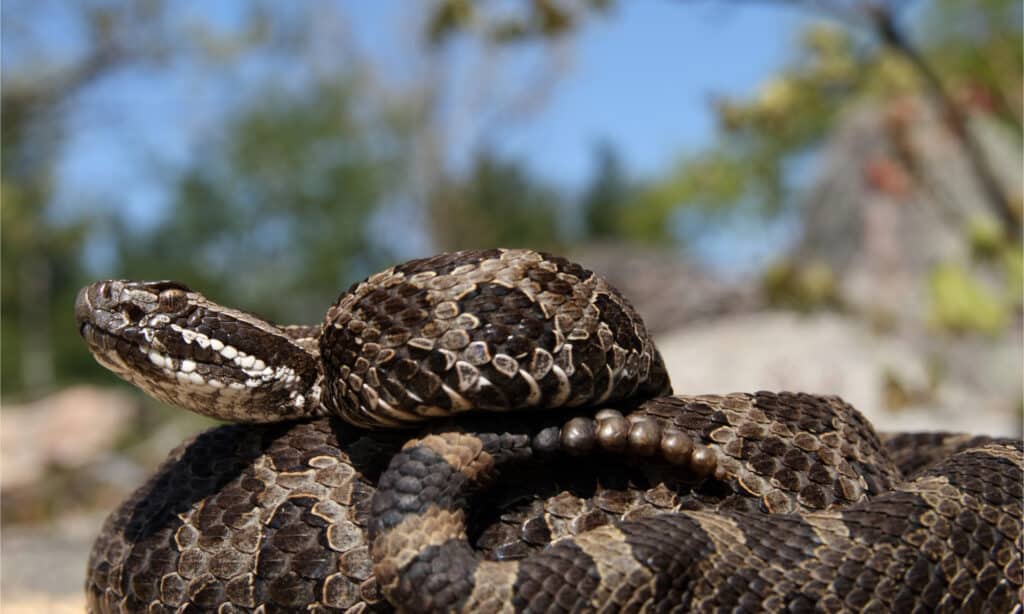
Eastern massasauga rattlesnakes typically prefer wet area habitats.
©Ryan M. Bolton/Shutterstock.com
| Eastern Massasauga Rattlesnake | |
|---|---|
| Range | Western & Northern Ohio |
| Length | 20-30 inches |
The Eastern Massasauga Rattlesnake lives in scattered populations in western and northern Ohio. Before early settlers came to the state, this rattlesnake lived in many prairies across Ohio. However, over time many of the state’s swamps were drained for farmland, destroying much of the snake’s native habitat and range. Today eastern massasaugas are rare in Ohio and are listed as an endangered species by Ohio’s Department of Natural Resources.
Eastern massasauga rattlesnakes typically prefer wet areas like bogs, wet prairies, swamps, and the mouths of rivers. In fact, “massasauga” means “great river mouth” in the Chippewa language. These snakes are sometimes called “black snappers” or “swamp rattlers” as well. Eastern massasauga rattlesnakes do not like open water and prefer areas with plenty of hiding places.
Appearance and Behavior
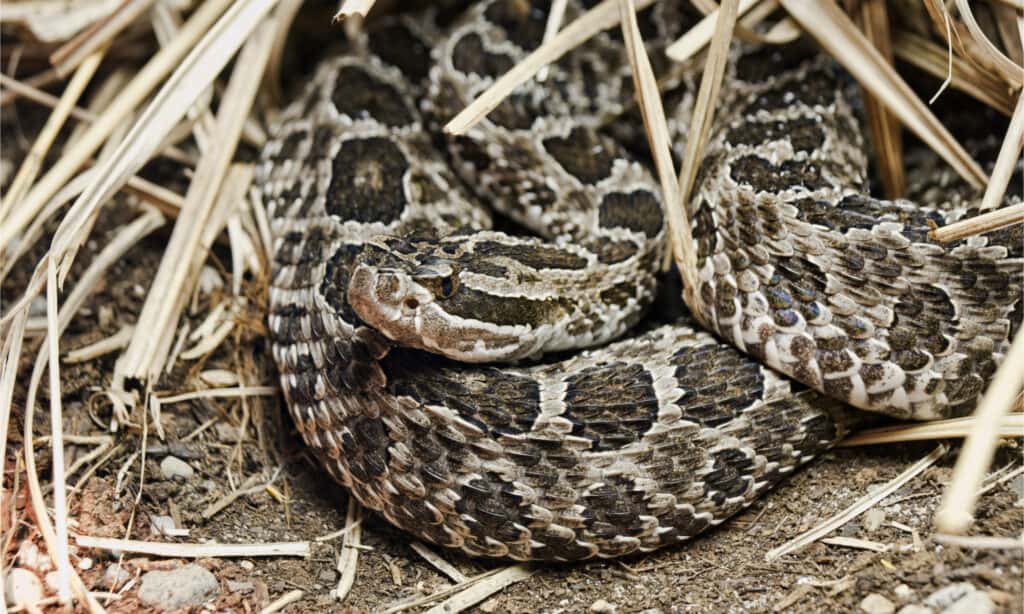
Eastern massasauga rattlesnakes’ small teeth mean they can’t inject much venom into their bites.
©DnDavis/Shutterstock.com
Although they can be dangerous, eastern massasauga rattlesnakes are small, shy, and reclusive. These snakes only grow between 20-30 inches in length, with thick stocky bodies that are tan or grey. There are many dark blotches across their backs and smaller blotches along their sides. Some of Ohio’s eastern massasaugas have very dark colors, making them look almost entirely black, except for their chins and throats. Young massasauga rattlesnakes have lighter coloring than the adults, with distinct colors and markings. Eastern massasauga rattlesnakes also have very small rattles that can be hard to hear.
During the winter eastern massasauga rattlesnakes brumate together in small groups, usually in areas with moist soil. When the weather warms up in the spring, they venture out to hunt and mate. Eastern massasaugas eat small mammals, like voles, mice, and shrews. They also eat other small species, like small birds, salamanders, small snakes, and small frogs. Eastern massasauga rattlesnakes have very toxic venom, but because they have small teeth, they cannot inject a lot of venom into their bite. These snakes mate between April and May, and give birth to 3-19 live young between July and September. Baby massasauga rattlesnakes are usually 7-10 inches long.
2. Timber Rattlesnake
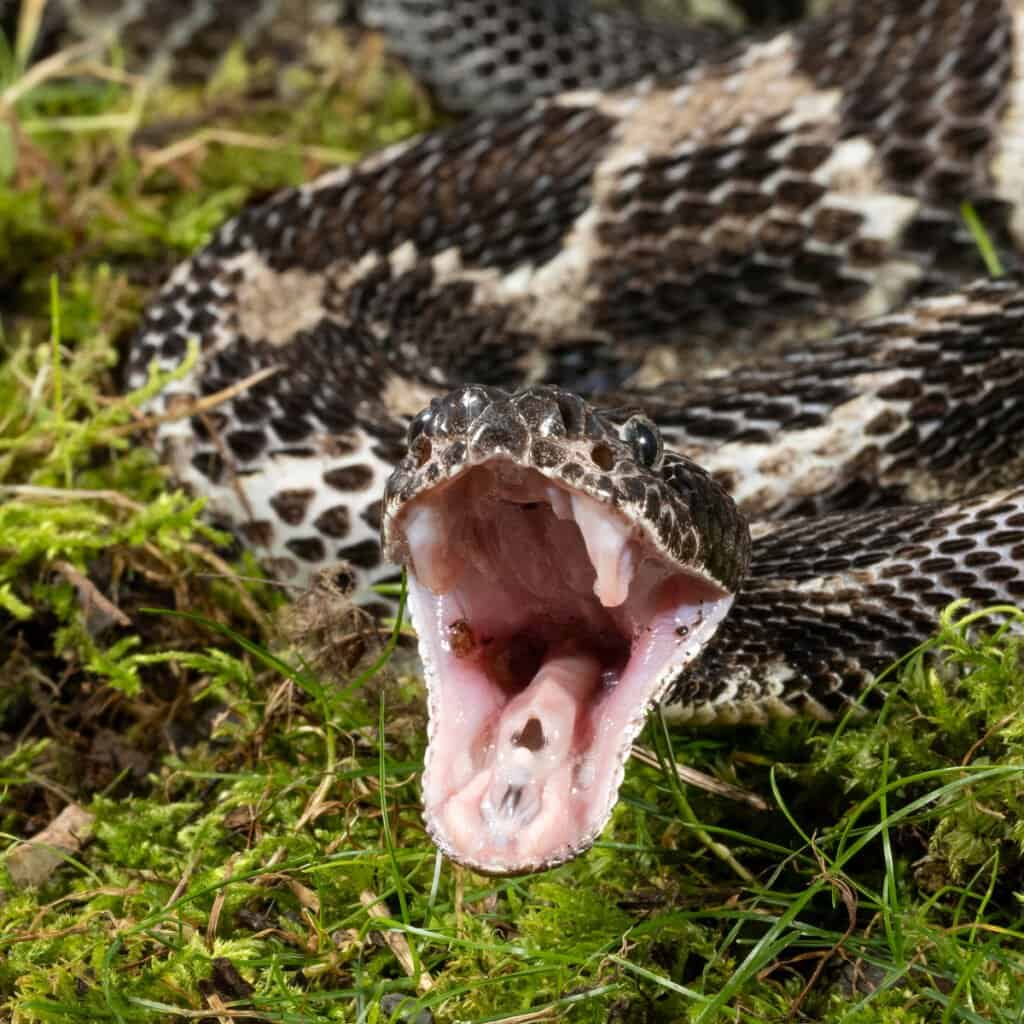
The timber rattlesnakes is the most venomous snake in the U.S.
©Joe McDonald/Shutterstock.com
| Timber Rattlesnake | |
|---|---|
| Range | Extreme North & South Ohio |
| Length | 30-60 inches long |
The Timber Rattlesnake is an endangered species in Ohio. It originally lived in 22-24 different counties in Ohio. Today, however, this snake is only found in 8 counties in the extreme northern and southern regions of the state. This snake typically lives in wooded areas with plenty of shade mixed with some sunny areas. Timber rattlesnakes are excellent climbers—some have been reported in trees nearly 80 feet off the ground! However, timber rattlesnakes are not very aggressive. In fact, these snakes usually remain calm around humans and large animals, choosing to stay quiet and motionless or slither away silently.
Timber rattlesnakes are one of the most dangerous venomous snakes in northeastern America — mostly due their size and the quantity of venom. When threatened, a timber rattlesnake will shake its sometimes large rattle as a warning before striking. But bites from a timber rattlesnake are extremely uncommon, as this snake will only bite as a last resort. Always be cautious, however, as they can strike up to 1/3 – ½ of their body length.
Appearance and Behavior
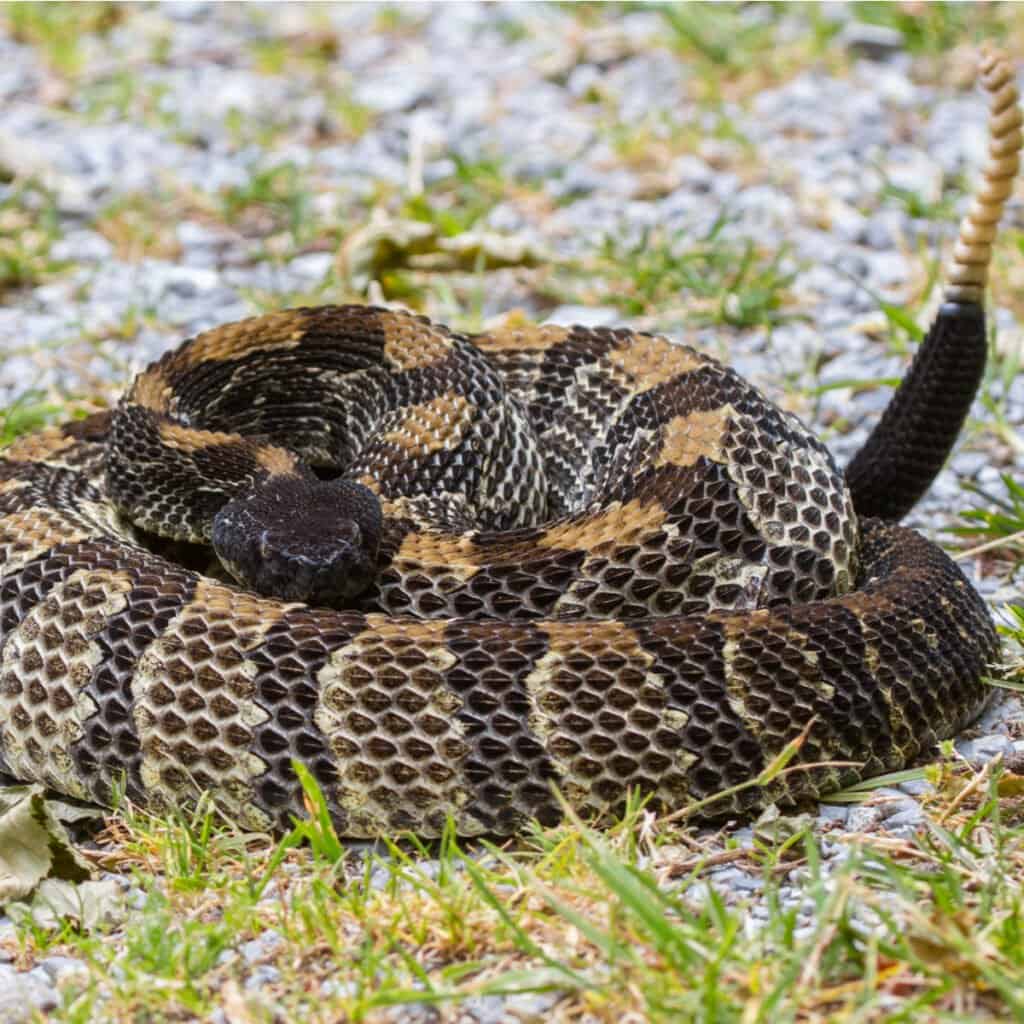
The timber rattlesnake has a large, prominent rattle.
©Frode Jacobsen/Shutterstock.com
Timber rattlesnakes are large snakes, growing up to 74 inches in length! However, these snakes are usually only 30-60 inches long on average, with yellow, brown, gray, or black bodies. Their thick bodies are marked by dark chevron crossbands and end with a large, prominent rattle on the end of their tails. The bodies and markings of some timber rattlesnakes are so dark that they appear almost entirely black. Timber rattlesnakes have large, triangular-shaped heads with vertical pupils and heat-sensing “pits” between their nostrils and eyes.
During the fall and spring, timber rattlesnakes are more sluggish due to the cold temperatures. When it warms up in the summer, however, these snakes are quite active, hunting chipmunks, squirrels, rats, mice, and amphibians. Timber rattlesnakes use deep rock crevices for dens, where they brumate with several other snakes through the winter.
Other Snakes in Ohio
In addition to the timber rattlesnake, the eastern massasauga rattlesnake, and the copperhead snake, there are 24 other nonvenomous snake species living in Ohio. Let’s take a look at a few of the nonvenomous snakes in Ohio.
Eastern Garter Snake
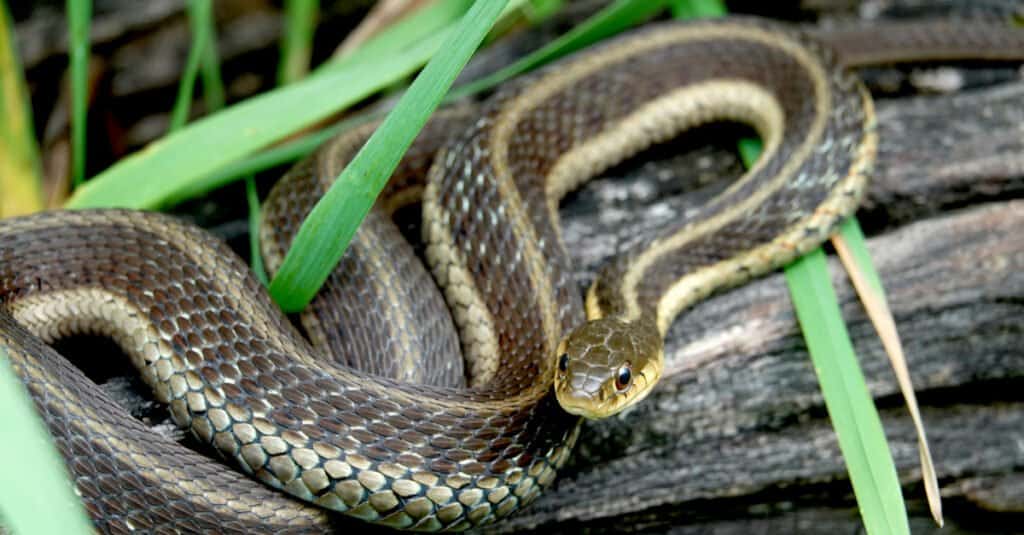
Garter snakes don’t have fangs and aren’t venomous. However, they do have a few rows of small teeth and can bite.
©Erik Agar/Shutterstock.com
| Eastern Garter Snake | |
|---|---|
| Range | All of Ohio |
| Length | 30 inches |
There are 5 different types of garter snakes in Ohio: the common garter snake, the eastern plains garter snake, the eastern garter snake, Butler’s garter snake, and the eastern ribbonsnake. The most common type is the Eastern garter snake, which lives all throughout Ohio. These snakes tend to live in forests, fields, and less populated areas, although they can sometimes be found in gardens as well. Because of this, they are sometimes referred to as “garden snakes” instead of garter snakes. Eastern garter snakes are typically 30 inches long with thin, slender bodies. They eat small mice, amphibians, fish, earthworms, and slugs.
Eastern Rat Snake
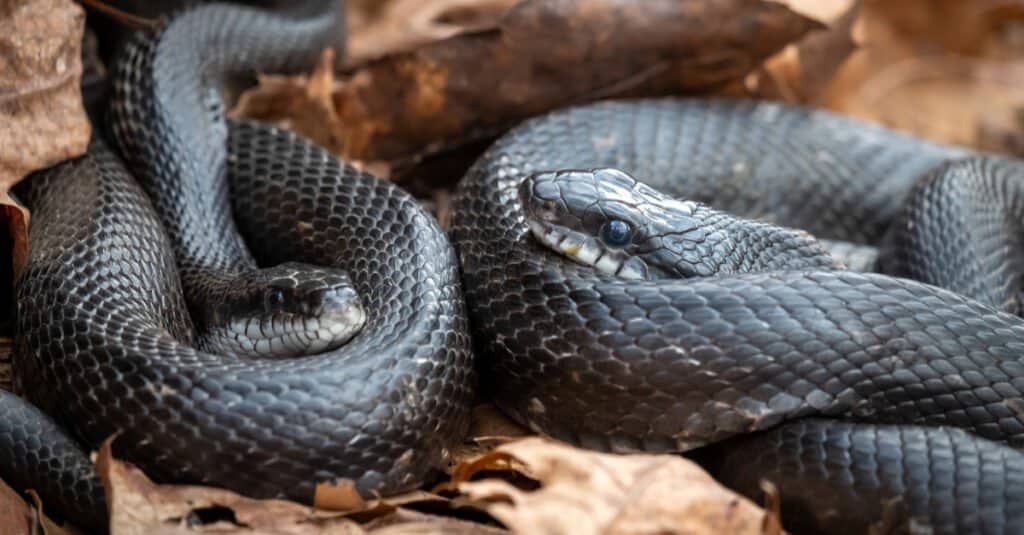
Eastern rat snakes live in forests, woodlands, fields, and farmland areas.
©samray/Shutterstock.com
| Eastern Rat Snake | |
|---|---|
| Range | All of Ohio |
| Length | 48-72 inches |
The Eastern Rat Snake is the largest snake in Ohio, typically measuring between 48-72 inches. These snakes live throughout most of Ohio in forests, woodlands, fields, and farmland areas. Eastern rat snakes are excellent climbers and often climb trees looking for prey or crevices for shelter. These snakes have smooth black scales along their backs, often with distinct or faded patterns. Their bellies, chins, and throats are white or light-colored. Unfortunately, the eastern rat snake is commonly persecuted by humans out of fear because of its large size. These snakes can deliver a painful bite, but generally they are docile, and they are not venomous.
Common Water Snake
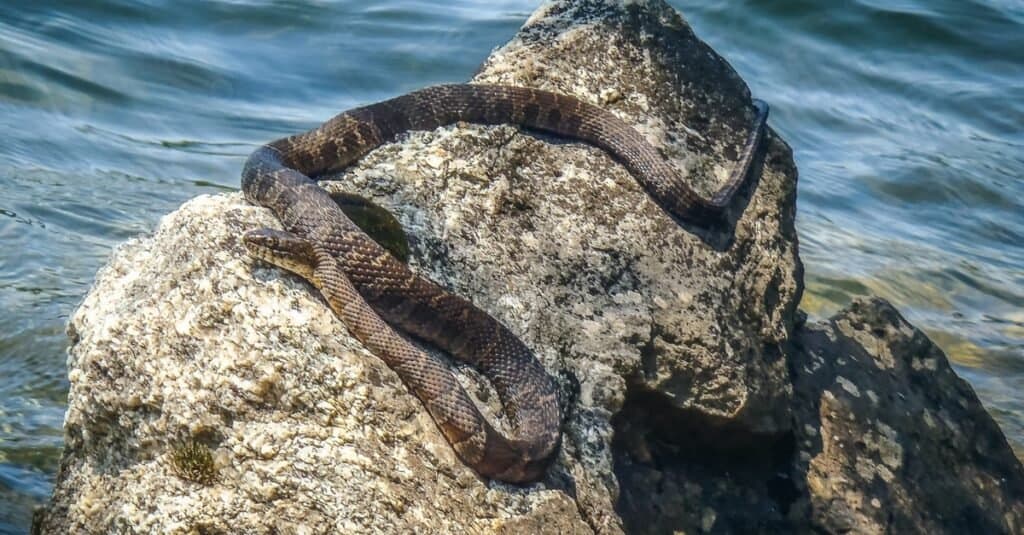
The common or northern water snake has a flat head that is as wide as its neck.
©jmarino/Shutterstock.com
| Common Water Snake | |
|---|---|
| Range | All of Ohio |
| Length | 24-54 inches |
The Common Water Snake lives throughout most of Ohio, typically in and around permanent bodies of water. These snakes often bask in the sun on logs, rocks, tree stumps, and even in low hanging branches above the water. Common water snakes are not venomous. They are cautious and try to avoid humans, but if encountered they can be very aggressive and they bite hard. Common water snakes come in a variety of colors and patterns. They can be brown, red, gray, or brownish-black with dark blotches or bands along the length of their bodies. Common water snakes are frequently mistaken for the venomous cottonmouth (or water moccasin) snake. However, there are no cottonmouth snakes in Ohio. Common water snakes are typically 24-54 inches long. These snakes are also called banded water snakes, or northern banded water snakes.
Other Water Snakes Found in Ohio
The common water snake is not the only snake species that living in the waters of the “Buckeye State.” There are two other “true” water snakes present in Ohio: the copper-bellied water snake and the Lake Erie water snake, a subspecies of the common water snake.
The copper-bellied water snake is very rare in the state, only inhabiting one Ohio county: Williams County. It is primarily aquatic and makes its home in shallow wetlands due to the food sources such as frogs that are plentiful. The average length of this snake is 3-4 feet and its colorings are virtually always black on the base and a stomach of orange-red shades.
The Lake Erie water snake is nonvenomous and can be found in Ohio on the islands of Western Lake Erie and in Ottawa County. While males grow to 28 inches long, females are larger and can reach 35 inches long. Its grey colorations help the snake to camouflage itself among the gray stones of its habitats. The round goby makes up around 90% of this snake’s diet since its introduction to Lake Erie in the 1990s. Find out more about other snakes in Ohio here.

Copper-bellied water snake is found in one county in Ohio.
©Mike Wilhelm/Shutterstock.com
What State Has the Most Snake Attacks?
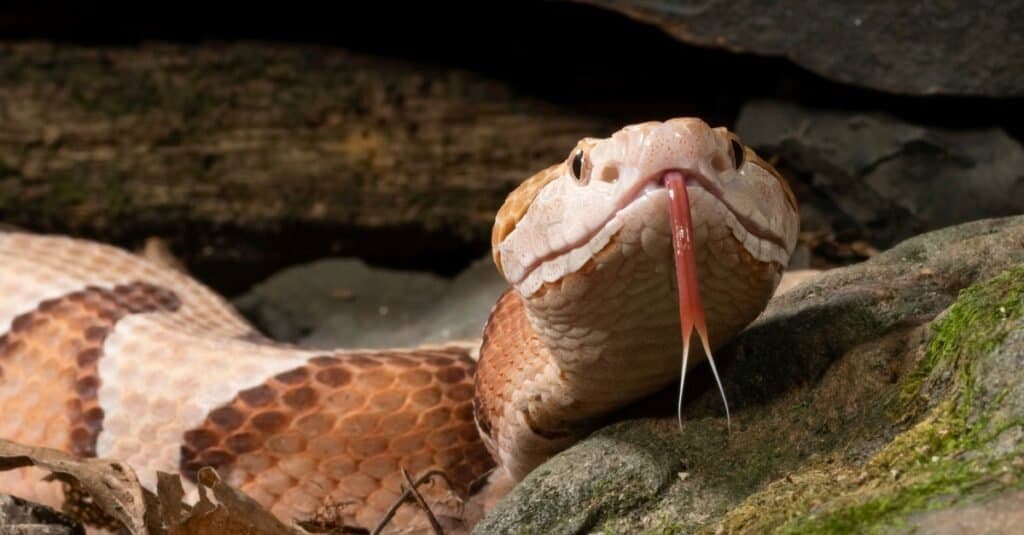
The venomous copperhead snake is among the snakes responsible for snake bites in North Carolina.
©Joe McDonald/Shutterstock.com
While snake bites do occur in Ohio, data on the estimated reported snake bites annually is lacking. However, there is data on the states where snake bites are more common. So what state ranks the highest in snake bites? That would be North Carolina. This southeastern state’s bite rate is 157.8 bites per million population per year. How does that average out? Well, the population as of 2021 was a little over 10 million (10.55 to be exact). If we were to just figure it off of 10 million, that would mean that there are roughly 1,580 reported snake bites per year.
The top 6 states for reported snake bites are as follows:
- North Carolina–157.8 bites per million
- West Virginia–105.3 bites per million
- Arkansas–92.9 bites per million
- Oklahoma–61 bites per million
- Virginia–48.7 bites per million
- Texas–44.2 bites per million
In North Carolina, there are 6 different kinds of venomous snakes: copperhead, cottonmouth, timber rattlesnake, pigmy rattlesnake, eastern diamondback rattlesnake, and eastern coral snake. In 2019, 92 people were bitten by venomous snakes in that state.
The photo featured at the top of this post is © DnDavis/Shutterstock.com
Discover the "Monster" Snake 5X Bigger than an Anaconda
Every day A-Z Animals sends out some of the most incredible facts in the world from our free newsletter. Want to discover the 10 most beautiful snakes in the world, a "snake island" where you're never more than 3 feet from danger, or a "monster" snake 5X larger than an anaconda? Then sign up right now and you'll start receiving our daily newsletter absolutely free.
Thank you for reading! Have some feedback for us? Contact the AZ Animals editorial team.






